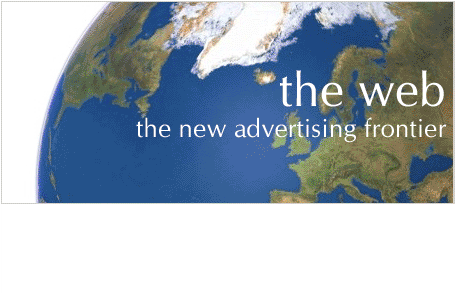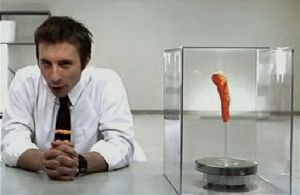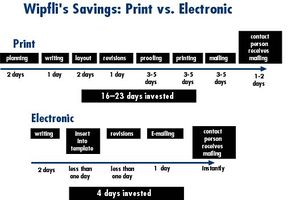CPSC203 2008Fall T19 Group4
Contents
- 1 Statement: The Past, Present and Future of Online Marketing
- 2 The History of Online Marketing
- 3 Disadvantages of Traditional Marketing
- 4 Older Types of Internet Marketing
- 5 New Types of Marketing
- 6 The Efficiency of Internet Marketing
- 7 The Future of Online Marketing
- 8 References
- 9 Group
Statement: The Past, Present and Future of Online Marketing
It has always been the job of the Marketing department of every business to find ways to advertise and promote the product or service of their company. Innovations have spanned from print ads, television, radio, and billboards, but in our modern society, one form of marketing has risen above all others. None other than: Internet Marketing.
The History of Online Marketing
Internet advertisements have had a very short but vibrant history. It's hard to imagine, but internet advertisement initially started in 1994. No money was spent on internet advertising at all in 1994, whilst in 1996, it became a $301 million dollar industry.
Booming Development of Internet Marketing
As the Internet's popularity increased through the nineties, so did the amount spent for advertising, as it quickly increased to a billion dollar industry in 1997. The initial ways of internet marketing were very simple and unsophisticated, as they were just text on websites. Graphics and pictures came later to keep consumers interested and increase interaction. In comparison with modern times, these websites were obsolete: if one wanted to purchase a good from the company they would call a number that was on the website and the product would be shipped later. After that, technology upgraded so that a consumer was able to purchase a good directly from the companies’ website. It continued to expand as secure methods of giving out credit card information were implemented. There was a spread of online auction sites throughout the web.
Later on companies began to place ads on websites to gain attention towards their product. Affiliate programs allowed for the Website owner to gain a percentage of the sold good by the endorsed companies. Internet marketing continued to progress as small firms marketed themselves to popular sites like Yahoo and paid the companies to allow banner adds to be displayed. Pay-per click advertisements were mutually beneficial to the website publishers and the company that sold the good.
Modern Use
Nowadays even politicians are deciding to use Internet marketing in order to get their message heard. A modern example of this is Barack Obama's campaign for the nomination for the Democratic Party as he used many social-networking sites such as Facebook and MySpace to ask for donations for his campaign. Obama received 10 million dollars in his second-quarter contributions by use of the Internet.
Disadvantages of Traditional Marketing
In traditional market, buyers and sellers trade face to face. Also, this kind of market takes a very large geographical area where customers are free to purchase the products that they like. A large group of sellers, however, compete with each other for customers. Therefore, advertising is necessary to attract customers to buy their products or brands. They can either choose advertising in television, radio, print media and banners, etc. However, even though advertising by these ways can attract more customers' attention, it is not as effective as people think.
Television
There are some disadvantages in television advertising, such as limited time span, audience diversity, and high advertising avoidance. Moreover, due to the once aired advertisements, it tends to lose their uniqueness. It is very inconvenient that customers have difficulty to go back to refer to the advertisement that they are interested or missed.
Radio
People tend to listen to radio while they are working or driving; therefore, advertising by radio is not very effective too. Also, it is costly to advertise in radio. Similar to television advertising, people tend to switch to other satellite radio while there is a advertisement in the channel that they are listening to.
Print Media
Even though advertising in newspapers may be better than advertising in television or radio because people can both catch up on the news and look at advertisements, for the people who do not like to read news from newspaper, they do not get the advertisements. For example, new generation tend to read news in the Internet, so they are unlikely to buy newspapers and get the advertisement.
Older Types of Internet Marketing
Popups
Pop-ups occur when websites open new web browsers to display advertisements. There are several variations of “Pop-ups” including a popunder, a new browser window that opens under the current one. A popover (also known as an overlay) is an animated graphic that doesn't have a window in the usual sense but rather materializes on top of the current window. Popups and such are made usually by JavaScript, a programming language used to write code that's embedded in the HTML code automatically downloaded to your computer when you open a Web page. However, many Internet users were annoyed by pop-ups, there have been many programs which have been made to “block” pop-ups, so they can no longer appear.
Banner Ads
Banner ads range in size, and are usually embedded advertisements that are usually located along the outside edge of the website. They may vary in appearance, but all have the same basic function: if a user clicks on them, they will be redirected to another site. Companies who use banner ads may use them for the following functions: arrange to display other Web sites' banner ads in exchange for them displaying its ad, they can pay publisher sites to post its banner, or they can pay an organization - usually a banner network - to post the banner on a number of publisher sites.
New Types of Marketing
As older internet marketing techniques slowly die out and become increasingly less popular, there has been a recent emergence of new and innovative ways to attract the viewer's attention. Several of the these ways appear to have a more subtle approach to advertising, and even on occasion, the viewer may not realize the discrete and often subliminal advertising that they are being exposed to.
Viral Marketing
Viral Marketing is a technique which relies on people who see, hear or read an advertisement sharing it with friends, family and other acquaintances, effectively meaning that they advertise the product for free, of their own volition.It's a technique which has existed since long before the creation of the internet, but which has only become common and effective recently, largely as a result of the changes to western culture as a result of the popularity and ready availability of the internet.
How does Viral Marketing work?
Viral marketing works differently from conventional advertising, in that it does not require a large number of people to see the actual advertisement to be effective, though often inducing more people to see the advertisement is an effective outcome of viral marketing. Rather than resulting in outright market saturation to advertise a product, viral advertisements usually have a relatively small number of initial viewers, who then tell other people about the advertisement, exponentially increasing the number of people affected without requiring extra input from the firm. Done properly this can be extremely effective, resulting in massive "overnight" success for the product being advertised.
What makes a Viral advertisement successful?
A viral advertisement requires two primary factors to be successful. First, it must be interesting. If people are not interested by the content or design of the advertisement, they will simply ignore and forget about it. This is even more important for a viral advertisement than a normal advertisement, since while someone may look at a boring advertisement that contains a product they are interested in, they will certainly not be compelled to share the message with others. The second important factor of a viral advertisement is that the basic message must be simple. Complex messages and statements, even if interesting, tend to be misrepresented and distorted over time, to the point that the advertisement will quickly lose any value as a marketing tool. Simple messages can be quickly relayed and help maintain the interest of the person hearing the message. While complex viral marketing schemes can be effective, they will also require much greater market saturation, while the advertisement itself will likely need to be easily and repeatedly accessable. An example of a proven way to create a successful viral advertisement is simply to offer some free service- hotmail.com and paypal.com have excellent marketing systems based on this principle.
Effect of Internet on Viral Marketing
The internet has proven to be the perfect venue for viral marketing. Because it is extremely easy for people to share information or show people a favorite video or article online, it is also much easier to induce individuals to assist a viral marketing campaign. Social networking sites and video sharing sites, such as MySpace and YouTube have proven to be particularly effective at spreading a viral advertisement, because a single person can quickly and easily spread information about an advertisement to dozens or even hundreds of other people, who can then do the same themselves.
Some effective Viral Marketing Campaigns include:
- The American presidential campaigns of Geogre W. Bush and Barack Obama
- Ebay, the popular online marketplace and auction site
- Cloverfield, an otherwise unremarkable movie, released during the slowest month of the year for box office sales.The movie proceeded to gross nearly $200,000,000 worldwide, largely due to it's marketing campaign. An accurate summary and analysis of the movie's campaign can be found here.
- Hotmail.com, one of the most-used email services in the world, as mentioned above.
Stealth Marketing
Stealth Marketing is a subset of viral marketing, in which a firm will attempt to simulate the viral effect by hiring a person to advocate their product without being a formal advertisement. Essentially, the person pretends to be an average user of the product while extolling it's virtues to the public, which then hopefully causes people to do the same themselves, or at least purchase the product. This technique is considered by some to be immoral and unethical, while others question it's effectiveness.
SmartAds
What Are SmartAds?
Smart ads are a form of targeted online marketing, which connects directly with consumers online by taking both user demographics and individual interests into account. Smart ads basically get to know the interests of the operator by what they search, and then they constantly supply related advertisements. These advertisements can arrive days, weeks or months later. Smart ads are very successful in the way that they have been able to make the way that advertisers connect and engage with their consumers in a cheap way more efficient. Smart ads were originally fully introduced by Yahoo in 2007, and are also known as super-targeted display ads. Although Yahoo’s SmartAds are still on top competitors such as Google Adsense and Microsoft are supplying heavy competition and pressure.
How Do Smart Ads Work?
Basically smart ads work off of the “customer insights,” such as previously visited websites and other cookies stored in the computer to build a unique add designed specifically for that individual. Smart ads guess the age, interests, gender, location ect of the individual. Although different companies that produce smart ads may have slightly different ways of getting the customer insights, they generally all work in the same way. Advertisers decide who they want to advertise the product to by creating sets of individual creative components; these creative components are then fed through the database of say Yahoo, and produce 100’s to 1000’s of individually targeted unique ads.
An example of how a smart ad works:
Megan lives in Vancouver, but hates the rain. One day she searches online for Mexico deals, perhaps dreaming of a sunny holiday. Later, when she’s looking up Yahoo Weather, she sees a display ad that plays to this interest, telling her about cheap flights to Mexico.
Are SmartAds Worth It?
Studies show that placing smart ads to significantly increase the number of clicks per page. They are also especially good for companies that have multiple different product offers based on different audience segments, because it only advertises the line of product most suitable for them. Testing conducted on Yahoo, smart ads generally resulted in a click rate two to three times higher than static, non-customized display ads using the same targeting and placement.
Affiliate Marketing
What is affiliate marketing?
Affiliate marketing is basically a chain, causing one website to drive traffic to another; the first website normally receives a profit for its service; basically online commission. Affiliate marketing was originally made known online through Amazon.com in 1996, with their “associate program.” Since then affiliate marketing has become incredibly popular among advertisers, because they only have to pay the affiliate if the ad is clicked, likewise the affiliate websites like it because they are able to make a profit and in turn it makes there sight more popular. Since 1996 amazon.com now has 450,000 websites in their affiliate program.
Example of an affiliate program:
A small website owner registers with Amazon (or any other affiliate program), they then put various links, banners, and products on their web site. When there visitors click through on these links and purchase a book or other product, the small web site owner is paid a commission for generating the sale.
Search Engine Optimism
What is it?
Search engine optimism is basically the process of increasing traffic to a particular website, usually through search engines. This is normally done through keywords, and website ranking (more clicks equal more popular). As far as marketing goes it is valuable to appear at the top of a search list; for people tend to only glance at the first or second search page.
Example of search engine optimism:
Jills favourite store is called Macintosh, but when she searches it into Yahoo she can’t find their website, which she knows that they have. She scrolls down the first five pages and eventually finds it on the bottom of the sixth; she later realizes that if she types Macintosh clothing co. Calgary it comes to the top of the first page. The words clothing, co and Calgary are all search words of that website.
The Efficiency of Internet Marketing
So why exactly makes internet marketing so effective?
- Easy Accessibility - These days, it’s uncommon to find a North American family without access to the internet, and with the growing development of the internet, more and more people spend their time surfing the “net”. The worldwide population on the Internet has exceeded billions of people, and there are thousands of new users every day.
- Targeted Advertisement- As a company looking for advertising opportunities to a specific market, internet advertising offers some targeting methods that insure that those who see your ads are the ones most likely to buy. New innovations such as SmartAds, match up advertisers with content that their target market examines regularly. The Internet is a direct, targeted marketing paradise. Typically a traditional direct mail piece yields a 1% to 2% response rate from non-clients, and 5% to 7% response rate from clients. On the other hand, sending electronic versions of direct mail pieces yields response rates of up to 20%.
- Tracking - Tracking the efficiency of newspaper and television advertisements is difficult. However, internet advertising allows the advertiser to track the number of impressions an ad can get, and how many visits their business web site gets from particular ads, making it easy to see what kind of conversion rates internet advertisements are getting.
- Cost - Many start-up businesses have a limited budget, and internet advertising can be much more in reach than traditional methods. Paper ads can cost up to hundreds of dollars, to print just in a telephone directory. However, you can bid for advertisements on websites such as Google on a performance basis; the user is only charged when visitors click on the advertisement, a win-win situation for both.
The Future of Online Marketing
As we've all read in recent years, the Internet is in its infancy, and webmasters have only begun to tap its potential. The same can certainly be said for Internet advertisers, and since advertising is the main source of revenue the keeps Web sites going, you can be sure it will continue to evolve at an accelerated rate. It’s difficult to predict what form or shape Internet Marketing will take, but with the millions of dollars that are being invested into Internet Marketing, we can only expect bigger and better things to come.
References
Hristo
- History of Internet Marketing, ECommerce, 2008: http://ecommerce.hostip.info/pages/708/Marketing-Internet-HISTORY-INTERNET-MARKETING.html
- Obama's Viral Marketing Campaign, Time, 2008: http://www.time.com/time/magazine/article/0,9171,1640402,00.html
- Banner Ads, PG, 2008: http://www.apromotionguide.com/banners.html
- Aranda, N., A Brief History of Internet Marketing, Ezine, 2007: http://ezinearticles.com/?A-Brief-History-of-Internet-Marketing&id=434488
- Bristol-Myers Squibb: http://www.bms.com/aboutbms/data/index.html
- Summary Data for Barack Obama, OpenSecrets, 2008: http://www.opensecrets.org/pres08/summary.php?id=N00009638
Sean
- Wilson, F., Six Simple Principals of Viral Marketing, 2008: http://www.wilsonweb.com/wmt5/viral-principles.htm
http://www.techcrunch.com/2008/04/21/facebook-publishes-insiders-guide-to-viral-marketing/
- Dellaporta J., What Is Viral Marketing?, 2008: http://www.wisegeek.com/what-is-viral-marketing.htm
- Howard, T., "Viral advertising spreads through marketing plan", 2005: http://www.usatoday.com/money/advertising/2005-06-22-viral-usat_x.htm
- Stanford's Entrepreneurship Corner: http://ecorner.stanford.edu/authorMaterialInfo.html?mid=379
- BBC: http://www.bbc.co.uk/worldservice/learningenglish/radio/specials/1557_london_extra/
Kin
- More Business, 2008: http://www.morebusiness.com/bang-for-advertising
- nydailynews.com (Print)
Carol
- Wilson, F., Are You New to Internet Marketing?, 2008: http://www.wilsonweb.com/admin/p_newbie.htm
- Wolf L., AICPA, Internet Marketing—The End of Traditional Marketing as We Know It: http://www.aicpa.org/pubs/tpcpa/feb2001/internet.htm
- SEO World, Traditional vs. Internet Marketing, 2007: http://seo-ph.blogspot.com/2007/09/traditional-marketing-vs-internet.html
- Greene S., 13 Hidden Benefits of Internet Marketing, 2002: http://www.sitepronews.com/archives/2002/oct/11.html
- CareerBluePrint, Benefits of Internet Marketing, 2006: http://www.internetcareerblueprint.com/resources/benefits-of-internet-marketing.shtml
- HowStuffWorks, Banner Ads, 2008: http://www.howstuffworks.com/banner-ad.htm
- Wegert T., Pop-Up Ads, Part 1: Good? Bad? Ugly?, 2002: http://www.clickz.com/991121
- Pictures: screenmatter.com (World), ismailzone.com (Marketing Strategy gif), straightdope.com (Pop-up), aicpa.org (Comparison)
Alicia
- Google SmartAds,Shareholder,2007: http://yhoo.client.shareholder.com/press/releasedetail.cfm?ReleaseID=252034
- SmartAds, blog,2007: http://blog.searchenginewatch.com/blog/070702-103231
- Yahoos SmartAds A Smart Idea?,seochat,2007: http://www.seochat.com/c/a/Search-Engine-News/Is-Yahoos-Smart-Ads-a-Smart-Idea/
- Unethical SEO,searchengineoptimism,2006:http://searchengineoptimism.com/Unethical_SEO_guarantees.html
- Search engine optimism,blog,2007: http://blog.luxamedia.com/seo/search-engine-optimism/
- Affiliate marketing, wikipedia, 2008: http://en.wikipedia.org/wiki/Affiliate_marketing
- Affiliate,incomeaccess,2008: http://www.incomeaccess.com/
- History,Amazon.com, 2008: http://www.amazon.com/
Group
- Alicia Hogarth
- Sean Straw
- Hrsito Minkovski
- Gordon Chow
- Carol Yan
- Class: CPSC 203
- Instructor: James Tam
- Tutorial: T-19
- T.A.: Mohammed Jafari





